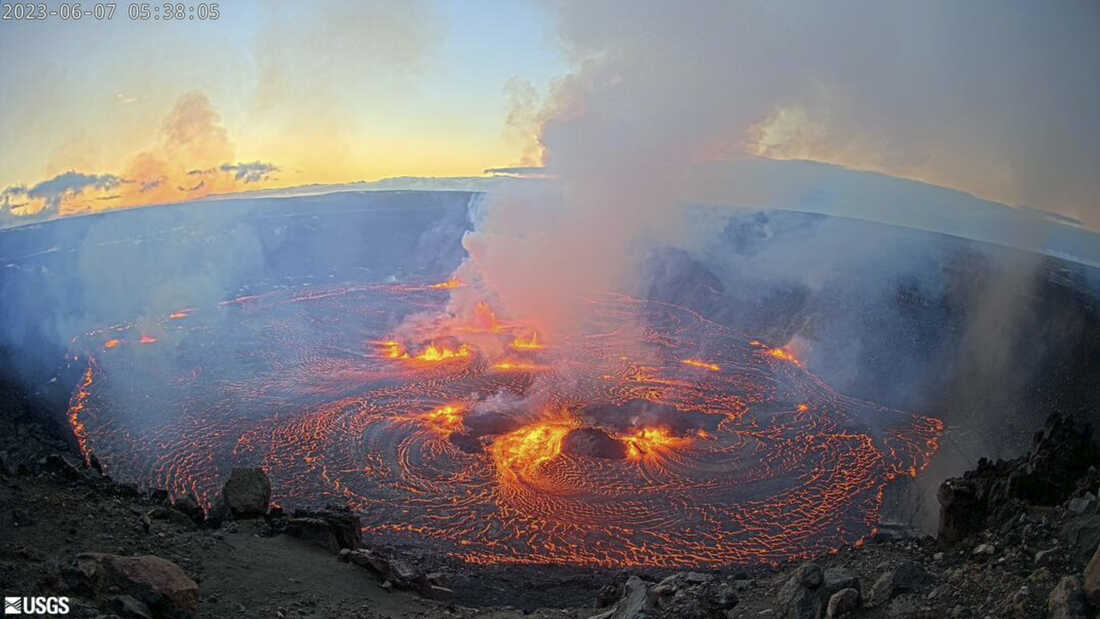Hawaii's Kilauea Volcano: A 40-Year-Old Eruptive Pattern Returns

Table of Contents
The 1980s Eruptive Cycle and its Parallels to Current Activity
The 1980s witnessed a period of intense volcanic activity at Kilauea, characterized by prolonged eruptions and significant lava flows. This period, lasting several years, saw the Pu'u 'Ō'ō eruption, a particularly notable event that reshaped the landscape and significantly impacted the surrounding environment. The current activity shows striking parallels to this earlier period.
-
Similarities between the 1980s and Current Eruptive Patterns: Both periods exhibit similar lava flow styles, predominantly effusive eruptions characterized by relatively slow-moving lava flows. The location of the eruptions, while not precisely identical, remains within the same general area of the East Rift Zone. The intensity of the eruptions, measured by lava flow rates and volumes, also shows comparable trends.
-
Key Data Comparisons:
- Lava Flow Rates and Volumes: While precise comparisons require ongoing analysis, initial data suggests comparable lava flow rates and cumulative volumes between the 1980s and current eruptions.
- Seismic Activity: Increased seismic activity, including swarms of small earthquakes, preceded both the 1980s eruption and the current event, indicating magma movement beneath the surface.
- Gas Emissions: Elevated levels of sulfur dioxide and other volcanic gases are being released, mirroring the significant gas emissions observed during the 1980s eruptions, impacting air quality in surrounding areas.
Geological Processes Driving the Eruptive Pattern
Kilauea's volcanic activity is driven by the underlying geological processes related to the Hawaiian hotspot and plate tectonics. The Hawaiian Islands are formed as the Pacific Plate moves over this hotspot, a plume of magma rising from deep within the Earth's mantle.
-
Magma Chamber Dynamics: The magma chamber beneath Kilauea plays a crucial role in the eruptive process. Pressure buildup within this chamber, caused by the influx of magma from the hotspot, eventually leads to eruptions. The size and pressure within the magma chamber are key factors influencing the intensity and duration of eruptions.
-
Types of Volcanic Activity: Kilauea predominantly exhibits effusive eruptions, characterized by the relatively gentle outpouring of lava. However, explosive eruptions, though less frequent, can also occur, particularly if magma interacts with groundwater.
-
Lava Composition: The chemical composition of Kilauea's lava, a basalt rich in iron and magnesium, significantly impacts its flow characteristics and the overall eruptive style. The viscosity of the lava influences how far and fast it flows.
Monitoring Kilauea's Activity: Technological Advancements and Their Role
Scientists employ a range of sophisticated monitoring techniques to track Kilauea's activity and improve prediction capabilities. Technological advancements play a vital role in enhancing our understanding of volcanic processes and mitigating potential hazards.
-
Monitoring Tools:
- Seismometers: Detect ground vibrations caused by magma movement.
- GPS: Measures ground deformation, providing insights into magma chamber inflation and deflation.
- Gas Sensors: Monitor the release of volcanic gases, providing clues about the intensity and potential hazards of eruptions.
- Satellite Imagery: Provides wide-area monitoring of lava flows, thermal anomalies, and changes in the landscape.
-
Early Warning Systems: The data gathered from these monitoring tools feeds into sophisticated models and early warning systems, allowing scientists to provide timely alerts to communities at risk. These advancements significantly improve our ability to predict volcanic activity and facilitate effective emergency response.
Impact on the Environment and Local Communities
Kilauea's eruptions have significant impacts on both the environment and local communities. Understanding these impacts is crucial for effective mitigation and planning.
-
Environmental Impacts:
- Air and Water Quality: Volcanic gases can degrade air quality, posing health risks. Lava flows can contaminate water sources.
- Wildlife and Vegetation: Lava flows can destroy habitats and displace wildlife. However, volcanic activity also creates new land and opportunities for ecological succession.
-
Impact on Human Populations and Infrastructure: Lava flows can damage or destroy homes, roads, and other infrastructure. The release of volcanic gases poses health risks to nearby communities. Evacuation plans and hazard mitigation strategies are essential to minimize risks.
Conclusion
This article highlighted the striking similarities between Kilauea's current eruptive phase and the activity witnessed in the 1980s. By analyzing the geological processes, sophisticated monitoring techniques, and impacts on both the environment and local communities, we gain a deeper understanding of this powerful and recurring volcanic phenomenon. The ongoing monitoring of Kilauea volcano activity is crucial for effective hazard mitigation and community safety. Understanding the recurring eruptive patterns of Kilauea Volcano is paramount. Stay informed about the ongoing activity of Kilauea Volcano through reputable sources like the USGS Hawaiian Volcano Observatory. Continue learning about Kilauea volcano activity and its impact to improve preparedness and ensure the safety of residents and visitors alike.

Featured Posts
-
 Rediscovering Spike Lee And Denzel Washingtons First Movie Together
May 06, 2025
Rediscovering Spike Lee And Denzel Washingtons First Movie Together
May 06, 2025 -
 Sabrina Carpenters Fortnite Festival A Complete Guide To Outfits Music And More
May 06, 2025
Sabrina Carpenters Fortnite Festival A Complete Guide To Outfits Music And More
May 06, 2025 -
 How To Get The Fortnite Sabrina Carpenter Skin A Complete Guide
May 06, 2025
How To Get The Fortnite Sabrina Carpenter Skin A Complete Guide
May 06, 2025 -
 Nachalos Ocherednoe Plenarnoe Zasedanie Milli Medzhlisa Glavnye Sobytiya Dnya
May 06, 2025
Nachalos Ocherednoe Plenarnoe Zasedanie Milli Medzhlisa Glavnye Sobytiya Dnya
May 06, 2025 -
 Tracee Ellis Ross Navigating Grief And The Dating World
May 06, 2025
Tracee Ellis Ross Navigating Grief And The Dating World
May 06, 2025
